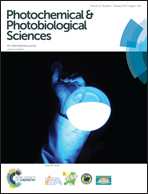A triplet–triplet annihilation based up-conversion process investigated in homogeneous solutions and oil-in-water microemulsions of a surfactant
Abstract
The triplet–triplet annihilation based up-conversion process, involving a platinum octaethyl-porphyrin (PtOEP) as a sensitizer and tetraphenyl-pyrene (TPPy) as an emitter, has been investigated in homogeneous solutions of toluene, bromobenzene and anisole, and oil-in-water microemulsions of the TX-100 surfactant, where toluene constitutes the non-polar phase. In homogeneous solutions, the highest up-conversion quantum yield (of the order of 20%) has been achieved in toluene, being the solvent that has the lowest viscosity among those explored. The up-conversion emission from the PtOEP–TPPy pair has been then investigated in a toluene based oil-in-water microemulsion at three different concentrations of the solutes, showing quantum yields up to the order of 1%, under the same irradiation conditions, but different deoxygenating procedures. The results herein reported might represent a good starting point for a future investigation in microheterogeneous systems. An optimization of the microemulsion composition, in terms of surfactant, co-surfactant and toluene concentrations, could allow us to increase the sensitizer and emitter concentrations and set up the best operative conditions to obtain even higher up-conversion efficiencies.


 Please wait while we load your content...
Please wait while we load your content...